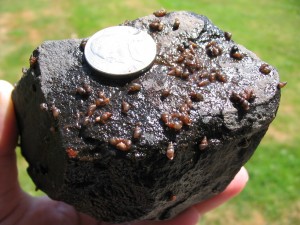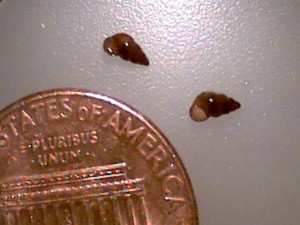By Moya Joubert and Lynn Kirby, City of Seattle
An invasive species of aquatic snail has been found in a Seattle-area stream that flows into Lake Washington. As part of their regular monitoring in 2009, USGS scientists sampled a site on Seattle’s Thornton Creek; recent analysis of the sample came back positive for New Zealand mudsnails (Potamopyrgus antipodarum). Additional sampling in May 2011 confirmed the presence of these invasive snails at the mouth of Thornton Creek.
New Zealand mudsnails (NZMS) reproduce by cloning, can live under a wide range of conditions, have no natural predators, and can dominate lake bed and river bed habitats. The snails can out-compete and crowd out native snails and insects that fish depend on for food. With little nutritional value of their own, New Zealand mudsnails can impact fish and other species.
The Thornton Creek discovery is the third confirmed detection of this invasive species in Washington. New Zealand mudsnails were first discovered in the lower Columbia River in 2002 and found in Olympia’s Capitol Lake in 2009.
The appearance of NZMS in Thornton Creek prompted state and local officials to help prevent this tiny species from spreading. A mini-workshop held at King County in July trained workers and volunteer groups entering Thornton Creek in proper decontamination procedures. The workshop was a joint effort of Washington Department of Fish and Wildlife, the Department of Ecology, King County, and Seattle Public Utilities. Jenifer Parsons of DOE addressed the basics of aquatic nuisance species and how to prevent their spread. The standard procedure for decontaminating field equipment is “clean, drain, and dry” with the understanding that drying time in Western Washington can be more than a month. Other decontamination methods were discussed at length.
NZMS, like other invasive species, are usually spread by recreational watercraft and trailers, recreational water users, fish stocking operations, natural resource management activities, dredging activities, aquatic plant trade and collection, and domestic and wild animals. The key to preventing the spread of invasive aquatic species is cleaning boats, trailers and equipment after each use. Freezing, hot water baths, and drying have proven effective at killing NZMS. Chemical alternatives like bleach, Formula 409, ammonia, grapefruit seed extract, isopropyl alcohol, benzalkonium chloride, potassium permanganate, and copper sulfate may be effective, but must be used carefully to prevent contamination of water bodies and damage to equipment.
For more information on NZMS and decontamination procedures, visit:
• http://public.wsu.edu/~dybdahl/researchsum.html
• http://www.anstaskforce.gov/spoc/nzms.php
• http://nas.er.usgs.gov/queries/FactSheet.aspx?speciesID=1008
• http://mudsnails.com/
• http://www.protectyourwaters.net/hitchhikers/mollusks_new_zealand_mudsnail.php
• http://www.clr.pdx.edu/projects/ans/nzms.php
• http://www.fish.washington.edu/research/oldenlab/research_invasives.html












